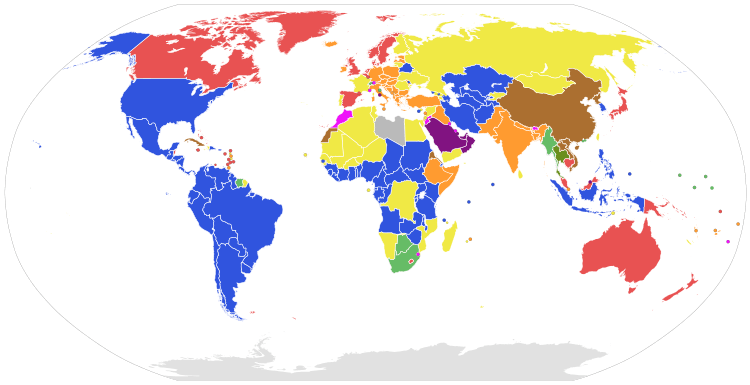One-party state
| Part of the Politics series | ||||||
| Party politics | ||||||
|---|---|---|---|---|---|---|
| Political spectrum | ||||||
|
||||||
| Party platform | ||||||
|
|
||||||
| Party system | ||||||
|
|
||||||
| Coalition | ||||||
|
|
||||||
| Lists | ||||||
| Politics portal | ||||||
A one-party state, single-party state, one-party system, single-party system is a type of state in which one political party has the right to form the government, usually based on the existing constitution. All other parties are either outlawed or allowed to take only a limited and controlled participation in elections. Sometimes the term de facto one-party state is used to describe a dominant-party system that, unlike the one-party state, allows (at least nominally) democratic multiparty elections, but the existing practices or balance of political power effectively prevent the opposition from winning the elections.
Concept
One-party states explain themselves through various methods. Most often, proponents of a one-party state argue that the existence of separate parties runs counter to national unity. Others argue that the one party is the vanguard of the people, and therefore its right to rule cannot be legitimately questioned. The Soviet government argued that multiple parties represented the class struggle, which was absent in Soviet society, and so the Soviet Union only had one party: The Communist Party.
Some one-party states only outlaw opposition parties, while allowing allied parties to exist as part of a permanent coalition such as a popular front. However, these parties are largely or completely subservient to the ruling party, and must accept the ruling party's monopoly of power as a condition of their existence. Examples of this are the People's Republic of China under the United Front, the National Front in former East Germany and the Democratic Front for the Reunification of the Fatherland in North Korea. Others may allow non-party members to run for legislative seats, as was the case with Taiwan's Tangwai movement in the 1970s and 1980s, as well as the Soviet Union.
Within their own countries, dominant parties ruling over one-party states are often referred to simply as the Party. For example, in reference to the Soviet Union, the Party meant the Communist Party of the Soviet Union; in reference to the pre-1991 Republic of Zambia it referred to the United National Independence Party.
Most one-party states have been ruled either by parties following the ideology of Marxism–Leninism and international solidarity (such as the Soviet Union for most of its existence), or by parties following some type of nationalist or fascist ideology (such as Italy under Benito Mussolini), or by parties that came to power in the wake of independence from colonial rule. One-party systems often arise from decolonization because one party has had an overwhelmingly dominant role in liberation or in independence struggles.
One-party states are usually considered to be authoritarian, to the extent that they are politically totalitarian. On the other hand, not all authoritarian or totalitarian states operate based on one-party rule. But very few, especially absolute monarchies and certain military dictatorships, have no need for a ruling party, and they make all political parties illegal.
The term "communist state" is often used in the West to apply to states in which the ruling party subscribes to a form of Marxism–Leninism. However, such states do not use that term themselves, seeing communism as a phase to develop after the full maturation of socialism, and instead often use the titles of "people's republic", "socialist republic", or "democratic republic". One peculiar example is Cuba. While the role of the Communist Party is enshrined in the constitution, no party is permitted to campaign or run candidates for election, including the Communists. Candidates are elected on an individual referendum basis without formal party involvement, though elected assemblies predominantly consist of members of the Communist Party alongside non-affiliated candidates.[1]
Examples

Current one-party states
As of 2017 the following countries are legally constituted as one-party states and the name of the one party in power both Marxist-Leninist and not:
Former one-party states
| Country | Party | Front | Date of establishment | Date of dissolution |
|---|---|---|---|---|
| |
Dahomeyan Unity Party | 1961 | 1963 | |
| Dahomeyan Democratic Party | 1963 | 1965 | ||
| |
Patriotic League | National Front for the Implementation of the Constitution | 1935 | 1940 |
Former big tent one-party states
| Country | Party | Date of establishment | Date of dissolution |
|---|---|---|---|
| |
Cameroon People's Democratic Movement | 1985 | 1990 |
Former left-wing one-party states
Former Marxist-Leninist one-party states
Former right-wing one-party states
| Country | Party | Date of establishment | Date of dissolution |
|---|---|---|---|
| |
National Autonomist Party | 1874 | 1916 |
| |
Gabonese Democratic Party | 1968 | 1990 |
| |
Islamic Republican Party | 1981 | 1987 |
| |
Democratic Party of Côte d'Ivoire – African Democratic Rally | 1960 | 1990 |
| |
Malawi Congress Party | 1964 | 1993 |
| |
Democratic Union of the Malian People | 1976 | 1991 |
| |
National Movement for the Development of Society | 1989 | 1991 |
| |
National Republican Movement for Democracy and Development | 1978 | 1991 |
Former fascist or nationalist one-party states
See also
- Ban on factions in the Communist Party of the Soviet Union
- Political organisation
- Dominant-party system
- Political factionalism
- Outline of democracy
- Multi-party system
- Two-party system
- List of political party songs
References
- ↑ Cuba: Elections and Events 1991–2001 Latin American Election Statistics Home